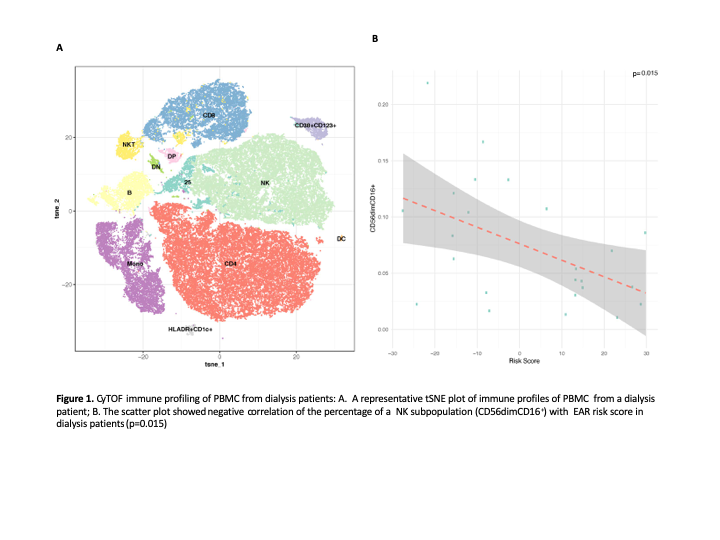Single Cell Profiling of PBMC Identifies Immune Populations Associated with High Risk of Early Acute Rejection
Icahn School of Medicine at Mount Sinai, New York, NY
Meeting: 2020 American Transplant Congress
Abstract number: 207
Keywords: Genomics, Kidney transplantation, Natural killer cells, Rejection
Session Information
Session Name: Basic: Acute Rejection
Session Type: Oral Abstract Session
Date: Saturday, May 30, 2020
Session Time: 3:15pm-4:45pm
 Presentation Time: 3:27pm-3:39pm
Presentation Time: 3:27pm-3:39pm
Location: Virtual
*Purpose: Our previous transcriptomic analysis of pre-transplant peripheral blood revealed a 23-gene set predictive of early acute rejection (EAR) post kidney transplant (JCI Insight, 2019). The associated immune profiles were further characterized at single cell level in this study.
*Methods: We first developed a reliable targeted RNA sequencing assay based on the 23-gene set and applied the assay to assess the EAR risk of 21 dialysis patients who were recruited at Mount Sinai Hospital. We next performed extensive singe-cell immune profiling of PBMCs of these patients using 33 surface markers with CyTOF technology. Lastly, using 10X genomics technology, we performed single cell RNA sequencing (scRNAseq) of the PBMC from two patients with high and low risk of EAR, respectively.
*Results: Using the established 23-gene assay to stratify patients, we identified had 6 high, 8 intermediate and 7 low risk patients. CyTOF immune profiling of PBMC of these patients indicated that high 23-gene risk score associated with decreased total NK (p=0.040) and NK T cells (p=0.032) compared to low risk score. Among NK subsets, CD56dimCD16+ subpopulation was the most significantly reduced in patients with high risk score (p=0.015) (Figure 1). Total CD4 T cells (p=0.016) and especially effector cells (CD45RA+/-CD25+CD127-) were significantly increased in patients with high risk score (p=0.031). Overall, scRNAseq analysis of the transcriptomic profiles of a total number of 11,966 cells confirmed the results of CyTOF experiments. We also observed association of NKT cell populations (decreased NKG7+CD4–CD8– and increased NKG7+CD4+CD8– cells) with EAR high risk.
*Conclusions: Our results support a role for NK in EAR and sets the basis for future studies testing the hypothesis that targeting NK cells improves outcomes after kidney transplantation.
To cite this abstract in AMA style:
Zhang W, Farouk S, Sun Z, Huang W, Yi Z, Fu J, Wei C, Fribourg-Casajuana M, He C, Cravedi P, Murphy B. Single Cell Profiling of PBMC Identifies Immune Populations Associated with High Risk of Early Acute Rejection [abstract]. Am J Transplant. 2020; 20 (suppl 3). https://atcmeetingabstracts.com/abstract/single-cell-profiling-of-pbmc-identifies-immune-populations-associated-with-high-risk-of-early-acute-rejection/. Accessed December 21, 2025.« Back to 2020 American Transplant Congress

